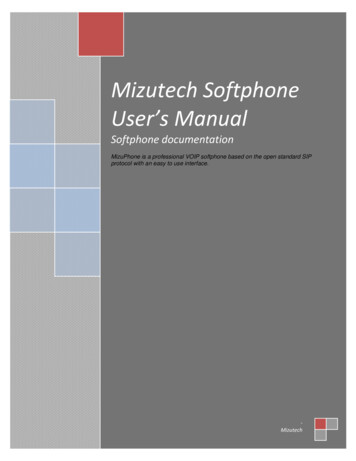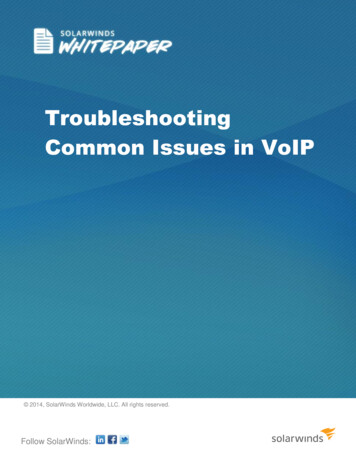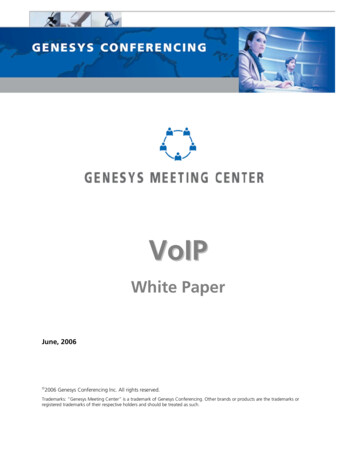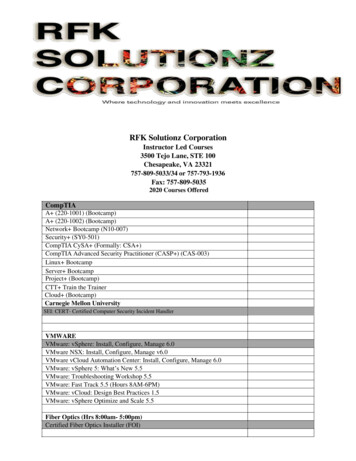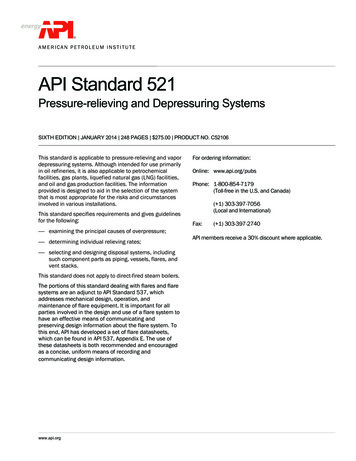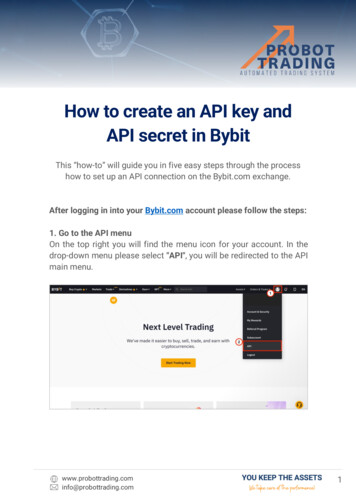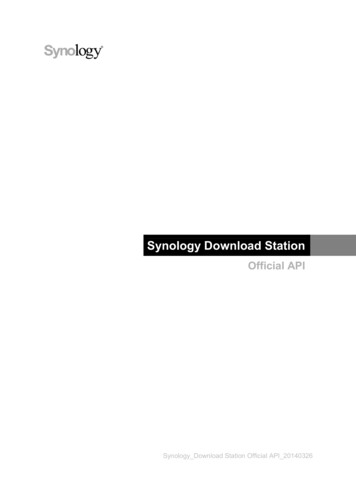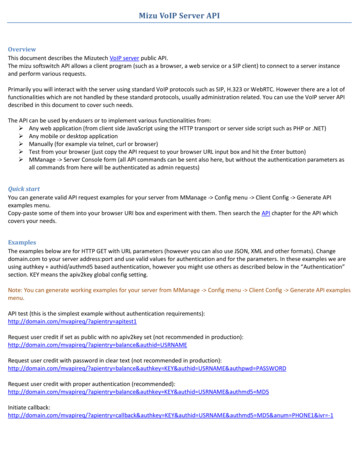
Transcription
Mizu VoIP Server APIOverviewThis document describes the Mizutech VoIP server public API.The mizu softswitch API allows a client program (such as a browser, a web service or a SIP client) to connect to a server instanceand perform various requests.Primarily you will interact with the server using standard VoIP protocols such as SIP, H.323 or WebRTC. However there are a lot offunctionalities which are not handled by these standard protocols, usually administration related. You can use the VoIP server APIdescribed in this document to cover such needs.The API can be used by endusers or to implement various functionalities from: Any web application (from client side JavaScript using the HTTP transport or server side script such as PHP or .NET) Any mobile or desktop application Manually (for example via telnet, curl or browser) Test from your browser (just copy the API request to your browser URL input box and hit the Enter button) MManage - Server Console form (all API commands can be sent also here, but without the authentication parameters asall commands from here will be authenticated as admin requests)Quick startYou can generate valid API request examples for your server from MManage - Config menu - Client Config - Generate APIexamples menu.Copy-paste some of them into your browser URI box and experiment with them. Then search the API chapter for the API whichcovers your needs.ExamplesThe examples below are for HTTP GET with URL parameters (however you can also use JSON, XML and other formats). Changedomain.com to your server address:port and use valid values for authentication and for the parameters. In these examples we areusing authkey authid/authmd5 based authentication, however you might use others as described below in the “Authentication”section. KEY means the apiv2key global config setting.Note: You can generate working examples for your server from MManage - Config menu - Client Config - Generate API examplesmenu.API test (this is the simplest example without authentication requirements):http://domain.com/mvapireq/?apientry apitest1Request user credit if set as public with no apiv2key set (not recommended in production):http://domain.com/mvapireq/?apientry balance&authid USRNAMERequest user credit with password in clear text (not recommended in production):http://domain.com/mvapireq/?apientry balance&authkey KEY&authid USRNAME&authpwd PASSWORDRequest user credit with proper authentication (recommended):http://domain.com/mvapireq/?apientry balance&authkey KEY&authid USRNAME&authmd5 MD5Initiate callback:http://domain.com/mvapireq/?apientry callback&authkey KEY&authid USRNAME&authmd5 MD5&anum PHONE1&ivr -1
Initiate phone to phone call:http://domain.com/mvapireq/?apientry p2p&authkey KEY&authid USRNAME&authmd5 MD5&anum PHONE1&bnum PHONE2Sending SMS message:http://domain.com/mvapireq/?apientry sms&authkey KEY&authid USRNAME&authmd5 MD5&anum PHONE1&bnum PHONE2&txt TEXTRequest rate to destination:http://domain.com/mvapireq/?apientry rating&authkey KEY&authid USRNAME&authmd5 MD5&bnum PREFIX OR NUMBERRecharge with PIN code:http://domain.com/mvapireq/?apientry charge&authkey KEY&authid USRNAME&authmd5 MD5&anum PINCODE&nowAdd credit: (from trusted IP only)http://domain.com/mvapireq/?apientry addcredit&authkey KEY&authid USRNAME&authmd5 MD5&pin USERNAME&credit AMMOUNTWith raw TCP or UDP you can send in the following format (terminated with a new line if TCP):/mvapireq/?apientry apitest&authkey KEY&authid USRNAME&authmd5 MD5With websocket, you have to use the uri with the “mvstwebsock” parameter such as:ws://yourserveraddress/mvstwebsock/Then send the request within the websocket stream as it would be TCP (the rest of the request line).ProtocolThe API is listening by default on port 80 for both UDP and TCP/HTTP/websocket (can be changed with the “mainaport” globalconfig option or disabled by setting the “usemainaport” to false). Secure access is also available if you have set a domain and SSLcertificate. More details can be found here.The API can accept commands and send answers in various format defined by the request or the “format” parameter.Transport protocolsUsually the API is accessed via HTTP or HTTPS however it also supports other methods which might be sometimes preferable forperformance, accessibility or other reasons.The following transport protocols can be used: UDP (up to 1490 bytes packet size)TCP (requests must be ended by CR/LF)TLS (if enabled)HTTP (1.0 or 1.1)HTTPS (if TLS is enabled)websocket (URI must contain “mvstwebsock”. Then send the request in websocket as you would send in HTTP URI)secure websocket (on port 443 if TLS is enabled)Tunnel (if encryption/tunneling is enabled)SIP (via special header if enabled)SMS (some commands are available also through SMS: p2p, cb, balance, rating, charge, cli. The SMS text must contain theparameters)Request/response formatA simple key/value protocol is utilized for the request with the following parts:
the “mvapireq” entry point string has to be used with all requests. A fix string as “mvapireq”. apientry (name of the API function such as “sms”, “balance”). See the “API” section below. authentication parameters (“authid” and “authpwd” or “authmd5”/”authsalt”). See the “Authentication” section below. function parameters (such as “anum”, “bnum”, “txt”, “param1” , “param2”). See the “Parameters” section below.More details can be found here.Supported data formats: plain text URL parameters (usually with HTTP GET: http://SERVER/mvapireq/?apientry function¶meter1 value1) parameters in http body (usually with HTTP POST) HTML form (submit) Ini format (key value) XML SOAP (SOAP XML) RDF JSON JSONP (JSON forward) works also for remote services if the “enablejsonp” global config option is set to 2(http://SERVERADDRESS/mvapireq/jppget?url .)For the response a code and/or a text is sent: code: 200 means success, 499 means failure text: all answers are suffixed with either “ERROR” or “OK”By default the answer format is guessed from the request, unless it is specified by the “format” parameter which can be set to oneof the followings (string in lower case): text cleartext html xml soap json jsonp (will respond with javascript callback code)If the httpstrictresponse is set to 1, then the response code is sent as html answer code (otherwise you will receive HTTP 200 OK forall requests and the real API response code will be in the message body).You can also use the old API over this new (all functions in the old API works also via this new API with mapped parameters).Shared service portAll API and Web related services on the Mizu server can be accessed via a single unified port. This case be set in the MManageconfiguration wizard (Network page - Access port) or via the mainaport global config option. Default value is 80 (the standardHTTP port).You can access the server via its IP address or domain name (if a domain name or sub domain have been set).You can use various transport methods for communication, including raw TCP, HTTP and WebSocket. UDP can be also used on thesame port by default or via another port set by the mainaportudp global config value.Most of the services can be also accessed via a secure port using the TLS protocol if you have configured a domain and SSLcertificate. This can be set on the config wizard as the “Secure Port” or in the global config with the following sslportmain andsslportweb values. Default value is 443 (the standard HTTPS port).Note: SIPS (TLS signaling) is listening on a separate socket and it can be set with the localtlsport parameter, defaulting to 5061.The server will auto-detect the service to be used from the request (transport, protocol, headers, URI parameters and otherheuristics) and the following services are accessible:
API (URL containing the /mvapireq path. For example:http://myserver.com/mvapireq/?apientry balance&authid testuser). With WebSocket the /mvstwebsock path must be setand send the request parameters in the packet body.Enduser web portal (URL containing the /webvoip or /webvoipportal path. For example: http://myserver.com/webvoip)TURN and STUN (auto detected if the packet is a valid TURN or STUN request)SIP (auto detected if the packet is a valid SIP signaling message)WebSocket SIP signaling (URL containing the /mfstwebsock path)MMQ services (URL containing the /mmstwebsock path. Rarely used.)Built-in fast web service for static files (URL containing the /mvweb path)HTTPS - HTTP forward (URL containing the hsforward parameter. This is a special service which is not enabled by default)Encrypted tunneling (if none of the above, it will be checked against some heuristics and if pass then it will treat asencrypted packets forwarded to tunnel decoder)Note: Some of the services (such as the webportal or the WebRTC signaling) are running in a separate process and can be accessed also directlyvia their internal listener portSecurityBefore execution, the server will authorize and authenticate each API request as described in the “Authentication” section below.Each API has a usage limit (rate-limit) to avoid overusing (DoS or brute-force) including for attacks tied to individual users, IP’s andglobal usage.AuthenticationEach API function requires an authentication which is a combination of the followings: ip authentication: if client ip must be in the allowed list defined by the “apiv2ipauth” global config api key: usually a “authkey” parameter have to be sent which have to match the “apiv2key” global config option (old“httpapikey”) user authentication: a valid username/password combination (or pin/did). For the password you can use the md5 hash andthis is strongly recommended instead of the clean text password. TLS/HTTPS can be also used for better security. other optional validations (such as device registered state, enduser credit or enforcing nonce authentication)The default API can be divided in the following categories: Sensitive API: IP and admin authentication is recommended for these. For example “newuseri” Admin API: for server administration, such as “info” to request server status details User API: API for users (such as “sms” to send SMS or “recharge” to add credit) by default with api key and username password or md5 authentication. Public API: for example “status” to request a user online status (for these you might allow username based authentication)The default API’s are set with optimal authentication (sensitive API’s requiring admin or ip access, local and same LAN IP’s aretrusted which you can change by adding them to tb api and set custom authentication), however for custom API’s (created by you)make sure that you set the proper authentication depending on the API sensitivity.For example some API might request IP apikey user authentication, while there are some API’s which you can set do require noauthentication at all (for example you can set the “status” API to require only a valid username). Usually (and by default) each apirequire apikey and user authentication (some API’s doesn’t require these from trusted sources). For admin requests an admin username/password has to be used (unless you change it).For bulk operations you might set the “trustediplist” global config option to your IP. For example your web server IP. Multiple IP canbe separated by comma.The following parameters are defined: authkey: Defined by the “apiv2key” global config option (optional) authid: Account username (but can represent also the user id, name, pincode or did)
authpwd: Account password in clear text (but can represent also the pin). This should be used only on trusted links such as onthe localhost. Otherwise better to use the authmd5 parameter.authsalt1: Need to be sent if the authmd5 (below) is used (a short random number or string)authsalt2: Need to be sent if the authmd5 (below) and the nonce is used (a short random number or string)nonce: Optional. The first 16 character of the server supplied nonce if nonce auth was enabledauthmd5: authv3 MD5(MD5(tU29m authid authpwd authsalt1) authsalt2 serversalt nonce )o MD5: message-digest algorithmo authv3 : hardcoded prefix string “authv3 ”o tU29m: hardcoded string “tU29m”o authid: account user nameo authpwd: account passwordo serversalt: salt defined by the “apiv2md5salt” global config option (optional, depending if configured on the server)o authsalt1: client side generated salt as sent by the “authsalt1” parameter (optional but highly recommended)o authsalt2: client side generated salt as sent by the “authsalt2” parameter (recommended if nonce is used)o nonce: only if nonce authentication was set (“preauth” was used)The above string parameters just have to be concatenated (no colon or space between them).The simplified formula for authmd5 without nonce looks like this:MD5(ck5Gp authid authpwd serversalt authsalt1)o MD5: message-digest algorithmo ck5Gp: hardcoded string “ck5Gp”o authid: account user nameo authpwd: account passwordo serversalt: salt defined by the “apiv2md5salt” global config option (optional, depending if configured on the server)o authsalt1: client side generated salt as sent by the “authsalt1” parameter (optional but highly recommended)The authentication can be fine-tuned in the tb api table. You can specify settings for existing API’s (for example you can force thebalance requests to be always authenticated) and you can also create new entries with custom SQL.The following fields are defined: fname: function name (api entry such as “sms”, “adduser” or “mynewcustomapi”) req key: 1 if authkey is required, otherwise 0 (default is 1) req ip: 1 if ip is checked, otherwise 0. If 1, then the allowed IP list can be defined by the “apiv2ipauth” global config option(default is empty which means only local ip). Local IP is trusted by default. Private/LAN IP is also trusted by default unlessyou set the trustlanip global config to false. req user: user authentication: 0 default,2 disabled,4 srvadmin,6 admins,8 owners and resellers, 10 support,11 SIPauthenticated users,12 all,14 public (default is 6 for admin API and 12 for user API) req user mode: defines how to authenticate the user. 0 default, 2 user pwd or pin (def), 4 user or pwd or pin (less),6 username/pwd (most). The default is defined by the “apiv2auth” global config option. Will also check the authenticationsetting of the user (so it might result in username only or IP based authentication) req user credit: allow API access only if user has credit. 0 means default auto, 1 means no check, 2 means minimum creditdefined by mincreditonroute, other means min credit value to check req user register: allow API access only if user is currently registered. null means def loaded from apidefneedregister, 0means no (don’t check registrar state), 1 means yes (user must be registered) req user login: allow API access only after login procedure. null means def loaded from apidefneedlogin, 0 means login isnot required, 1 means yes (login required) customsql: custom api based on an SQL query (in case if you set this for a predefined API, then the predefined behavior willbe lost and the API will use your custom SQL). You can write any query supported by the SQL engine, including storedprocedure usage if needed custom action: define a custom action for this API: 1 email, 2 sms, 3 call ring, 4 restart,5 mssqlrestart,6 reboot,7 run custom action body: body text for the above custom action (such as SQL query or email body) enabled: set to 0 to disable the API or 1 (default) to enable
Example:If you wish to set an existing API as public (with no authentication request) just create a new record in tb api with api entry string for fname, 14 for req user and4 for req user mode. The fname field must set to the exact name of the existing API entry (for example “balance”, “rating”, “sms” or others) if you wish tooverwrite the authentication for an existing API (Otherwise a new API entry will be created).For example If you wish to make the balance request API fully public, then just add a new record into tb api with the fname set to “balance” and the req key to 0and the req user set to 14 (which means public). Once this is set the balance can be requested as simple ashttp://serveraddress.com/mvapireq/?apientry balance&authid USERNAMENote: for the changes in the tb api to be applied you must issue a “apireload” command (from the Server Console) or restart your server.Hardened accessThe above described parameters already provide good enough access restrictions for the API for normal use case, including accessover the internet. By applying the following techniques described in this chapter, you can add even more security for your serverAPI access, if required for your use case.Global config options: apiv2md5salt: always set to a random value apidefneedregister (or tb api.req user register): access will be granted to user API only for those user who are alreadyauthenticated over SIP or WebRTC. Possible values: 0: no (default), 1: for users, 2: check also the IP allowtrustedip: You might set to to avoid ip spoofing. Possible values: 0 no,1 my ip only,2 private ip'sonly,3 yes(default),4 everywhere(including admin console) apitrustediponly. Possible values: 0 no (default),1 allow api requests from trusted ip only. If this is set to 1, then users will notbe access any API over the internet (not suitable for public services) apideftrustadmin. Specify how to recognize admin users. Possible values: 0: no, 1: admin if trusted ip (default), 2: always iponly, 3: always auth only, 4: always ip auth apialtauth. Specify whether to allow also alternative authentication //-1: auto guess, 0 strict username/password only,1 enable all mode (also clear text and pin) apitrustfromconsole. Specify whether to trust the admin console access. Possible values: 0 no,1 yes,2 as admin apidefneedlogin (or tb api.req user login): Force nonce validated authentication. Possible values: 0: no, 1: require from nottrusted sources, 2: yes, require, 3: yes, require with ip address verification remoteadmin. Specify whether to allow remote administration. Possible values: 0: disable, 1: from localhost/127.0.0.1, 2: fromsame machine, 3: from trusted sources, 4: from local LAN and subnet, 5: from everywhere. Default is 5.Note: Some parameters are extra filtered by default for SQL injection and XSS attack preventions (the database operationsperformed by the mizu voip server are always parameterized to avoid SQL injections, however these extra validations might help formitigating issues in third party application that you might use)For additional security you should use the API over encrypted HTTPS (not over unsecure HTTP).Optionally as a simple encryption/obfuscation, you can also encrypt the requests with XOR Base64 encoding. The XOR key can beset by the httpapiencryptkey global setting. Replace the ‘ ’ char with ‘-‘,the ‘ ’ char with ‘ ‘ and the ‘/’ char with ‘.‘ in the resultingstring if any. An online test tool for this can be found here (select the XOR Base64 option from the list). If you wish to encrypt the whole POST URI, then encrypt as described above and pass it as “mcrfs” parameter. If you wish to encrypt the parameters values, then encrypt as described above and prefix them with “oenc1 ” string.Using nonce for replay attach protectionBasic protection for replay attach is already enabled by default with the fix server salt (defined by apiv2md5salt) and client saltvalues (sent by the client with the authsalt parameter). Also by default the server will limit the API access after a few subsequentfailed authentication requests.For dynamic nonce verification, you must enable it with the apidefneedlogin global config option (set to 1 or 2) or individually forAPI entries by the tb api.req user login field value.When this is enabled, the client will always need to send a “preauth” API request first for which the server returns a nonce value(“OK: new nonce is:xxxEOF”).
The client then must use this nonce to calculate the authmd5 checksum (in addition to already mentioned field, it mustconcatenate also the nonce at the end) and also must send back the first 10 characters of the nonce with every request as thenonce parameter.If the apidefneedlogin global config or the tb api.req user login field is set to 2, then the client must be prepared to receive a“ERROR: new nonce is:xxxEOF” answer for any API request and in this case it must repeat the last request with the new nonce sentby the server (This is sent if the IP address of the client was changed or if there was no preauth request)ParametersParameters can be URI encoded. By default the basic ASCII character set are used.Parameters can be passed by the parameter names (as listed in the API section below []) or using param1, param2 paramn.Common parameters are the followings: authentication parameters: described below in the “Authentication” section. param1,param2,param3: this format can be also usually used. It must be in the same order as documented in the “API”section below. If you specify the parameters in this way, then the parameter order must be: functionname, apikey,username, password, function parameters (anum, bnum, text) anum/phone1/from: for first/from/originating phone number bnum/phone2/to: for second/to/target phone number txt/message: body for sms, email and others targetuser: admins can impersonate any other user by using this parameter now: you might append a new x parameter at the end of the URL query list for API usage tracking others: as listed in the “API” section below. Possible parameters are listed in brackets [].KeywordsThe following keywords are automatically replaced by the Mizu VoIP client apps, so it is possible to set some API’s (such as balancerequest and others) as SIP client configuration parameters which are then handled dynamically, at run-time: KEY: api key USERNAME: sip username PWD: sip password in clear text (should be used only with https) MD5CHECKSUM: mizutech old api: MD5("rD58s:" username ":" pwd ":" additional) MD5VALUE: mizutech new api: MD5("ck5Gp" username pwd apiv2md5salt usersalt) //the usersalt is optional MD5WEB: mizutech web MD5("C8y5:" username ":" pwd ":" additional); MD5NORMAL: MD5(username pwd salt) MD5SIMPLE: MD5(username pwd) SALT: salt for md5 calculation PHONE1, PHONE2, PREFIX OR NUMBER, CALLEDNUMBER: caller/called numbers PINCODE: pin code AMMOUNT: creditAPIThe supported commands (API entries / functions) are listed below.Parameters in []Short description in {}The best way to learn the usage is to try out the requests quickly from your browser. Some valid examples can be generated fromMMAnage - Config menu - Client config - Generate API examples. For example try the balance request example first once thatworks, just replace the apientry parameter to any of the below API entries and add other URI parameters as needed.User commandsCommands available for users (authenticated as enduser/reseller/other user type):newuseru {public add user} [u username,u password,u name,u email,u phone,u currency,u country,u address]balance {credit request}
callrating {call rating for an ongoing call returning credit, maxduration and rating for existing call} [username, callid]rating [bnum callednumber/prefix] { rate request}status {self online status. 0 doesn’t exists,1 offline,2 online,3 calling,4 speaking}verifyuser [userusername] {request the status of this user. 0 doesn’t exists,1 offline,2 online,3 calling,4 speaking}presence get [userusername/userlist,ptype,domain] { will return the presence status of one ore multiple users; ptype have to beset to 1 if called from timer and 0 when at start; answer: OK: puserlist: user1:status1,user2:status2 OR ERROR: errordescription }presence set [pstatus,ptype] {set presence status; pstatus means status string, ptype have to be set 0 when called at start,otherwise 1; answer: OK: xxx or ERROR: xxx (doesn't matter since we have nothing to do with it). Also offline user2:text2XOFFMESSAGE:}sendim [bnum/buserlist,txt] {send chat message}getconfroom {get/create conference room}callback [num] {initiate callback call}p2p [bnum, cnum, waitfor] {phone to phone call request. you can set the waitfor to 1 or 2 to wait for the call connect or failure}sendfax [from,to,filename]sendmail [from, to, subject, message] {from can be empty}sms [from,to,txt] {send sms message}sendsms [from,to,message] {send sms message asynchronously -fast}sendsmssync [from,to,message] {send sms message synchronously –wait for delivery answer}sendsmsunicode [from,to,message] {send sms message asynchronously -fast }sendsmsunicodesync [from,to,message] {send sms message synchronously -wait for delivery answer}cli {add pin less number (ANI)}charge [pin] {recharge using recharge PIN}cccharge credit [username,credit] (user A can send credit to user B)lockphonenumber {reserve a phone number}getphonenumber {return a phone number from the free pool)search {user search}callbackaccessnumber {return the callbackaccessnumber}addcallbacknumber {add custom callback number}changepwd [newpassword,oldpassword]forgotpasswordquestion [email]forgotpasswordanswer [email, forgotpasswordanswer]addcredit [pin] {add credit (Only from trusted IP by default)}callforward [anum,bnum,cnum]sendccinfovoicerecdownload format,fromdt,todt,caller,called] {download recorded voice}The format parameter can have the following values: 1: mp3, 2: wave, 3: mp3 zip, 4: wave zip.All other fields are used for CDR filtering (one or more files can be downloaded at once)getdetails [mode min/normal/max]setfield [fieldtype string/int/float, fieldname, fieldvalue,rowid, sync] {update a field in tb users}the following fields are voicemailonnoansw,voicemailalwaysthe following fields are allowed only if not set umber,birthday,gender,language,utc(These restrictions are applied only for user logins. Admins can change any fields in any table)cdr [caller,called,maxcount record count, days today/lastweek/lastmonth/daysnumber dir all/in/out type all/connected/notconnected, prefix, fields min/normal/all, summary no/yes, by all/day/caller/called, order date,caller,called,user]Admin commandsCommands available for administrators (authenticated as admin user and/or trusted IP address based authentication).
Diagnosticsversion {display software version number}hearthbeat [mode quick/full] {request server heartbeat}info {show server status and important parameters}regstat {registrar statistics}reguser [usr] {show registered users/devices}fastregusers [succ/all] {list fastreg module users}endpoints {list sip endpoint info}epreg [regtype, regstate] {list registrar endpoints}routingtest [ip,caller,called] {will return the destination route as it would be for real call}gencdr { generate cdr’s: www.mizu-voip.com/portals/0/files/gencdr.pdf }routingtestdeviceid {show device id}fastusers {list cached users}quickstat {quick statistics}locks {list of pending loks}threadlist {thread list}threads {thread list}threads2 {thread list}querylist {list the guid for the current running queries}fs {internal callshowlog [main/sip/gk/sh/tcp,lines] {show the requested logfile}logfile{will send the requested file}logsearchreportsshowcfg {show the config files}Commandsnewuseri {private fast/unrestricted add user from trusted source admin}[u username,u password,u name,u email,u phone,u currency,u country,u address]newuser {deprecated}adduser {deprecated}addserver {add sip server or traffic sender}[u type,u name,u username,u password,u domain,u ip,u port,u proxy,u transport,u auth,u email,u country,u currency,u credit,u routing,u routingpriority,fieldnameX/fieldvalX]deluser {delete a user by id or username} [u id or u username]listusers {list users} [u type, u maxcount, u extended, u order]cmd {exec windows shell command}asendemail [from, to, subject, message. from can be empty]smsreceive {for inbound SMS. See the SMS chapter in the admin guide for the details}asendsms [from,to,message] {send sms message asynchronously for high performance}asendsmssync [from,to,message] {send sms message and wait for the result}sendamsg {SendAgentMessage: send message to agents (agentid-all,message) }voicehere [dbcallid] {start realtime call listening}voicehere2 [username] {start realtime call listening}bannedlist {list of banned ip's}
delbanned [all] {remove ip from the banned list (ip)}unreg [username,ip,mode] {unregister user or “all”. If mode if 1 then remove instead of unreg}disccall [dbcallid]gk {connect to h323 gatekeeper module}client {switch to the requested client}db {any database query (select,update,etc) only if authenticated user type is admin}setip {set new ip (cardname,ip,mask,gateway,gwmetric)}tbackup { launch a database backup to the second server}timezoneset {set timezone}putfile [filename, filedata] {will save a file under the server directory. The filedata should be base64 encoded }getfile [filename] {will load a file from under the server directory }Resetreload {reload current configuration}vsiprst {restart sip-h323 router}sipreset {will reset the sip stack}maintreset {will restart the maintanance thread}ftprstwebrstresetpdbreset {reset database connections}restart {what service/serv
Admin API: for server administration, such as info _ to request server status details User API: API for users (such as sms _ to send SMS or recharge _ to add credit) by default with api key and username password or md5 authentication. Public API: for example status to request a user online status (for these you might allow username based .

